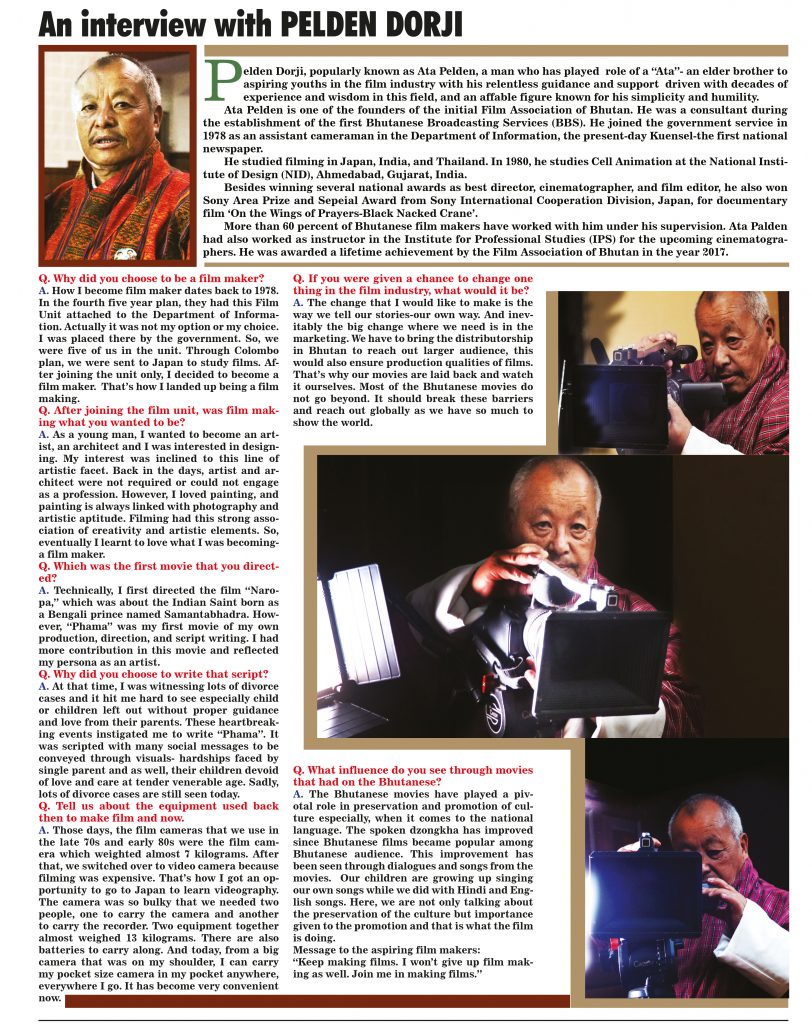Pelden Dorji, popularly known as Ata Pelden, a man who has played role of a “Ata”- an elder brother to aspiring youths in the film industry with his relentless guidance and support driven with decades of experience and wisdom in this field, and an affable figure known for his simplicity and humility.
Ata Pelden is one of the founders of the initial Film Association of Bhutan. He was a consultant during the establishment of the first Bhutanese Broadcasting Services (BBS). He joined the government service in 1978 as an assistant cameraman in the Department of Information, the present-day Kuensel-the first national newspaper.
He studied filming in Japan, India, and Thailand. In 1980, he studies Cell Animation at the National Institute of Design (NID), Ahmedabad, Gujarat, India.
Besides winning several national awards as best director, cinematographer, and film editor, he also won Sony Area Prize and Sepeial Award from Sony International Cooperation Division, Japan, for documentary film ‘On the Wings of Prayers-Black Nacked Crane’.
More than 60 percent of Bhutanese film makers have worked with him under his supervision. Ata Palden had also worked as instructor in the Institute for Professional Studies (IPS) for the upcoming cinematographers. He was awarded a lifetime achievement by the Film Association of Bhutan in the year 2017.
Q. Why did you choose to be a film maker?
A. How I become film maker dates back to 1978. In the fourth five year plan, they had this Film Unit attached to the Department of Information. Actually it was not my option or my choice. I was placed there by the government. So, we were five of us in the unit. Through Colombo plan, we were sent to Japan to study films. After joining the unit only, I decided to become a film maker. That’s how I landed up being a film making.
Q. After joining the film unit, was film making what you wanted to be?
A. As a young man, I wanted to become an artist, an architect and I was interested in designing. My interest was inclined to this line of artistic facet. Back in the days, artist and architect were not required or could not engage as a profession. However, I loved painting, and painting is always linked with photography and artistic aptitude. Filming had this strong association of creativity and artistic elements. So, eventually I learnt to love what I was becoming-a film maker.
Q. Which was the first movie that you directed?
A. Technically, I first directed the film “Naropa,” which was about the Indian Saint born as a Bengali prince named Samantabhadra. However, “Phama” was my first movie of my own production, direction, and script writing. I had more contribution in this movie and reflected my persona as an artist.
Q. Why did you choose to write that script?
A. At that time, I was witnessing lots of divorce cases and it hit me hard to see especially child or children left out without proper guidance and love from their parents. These heartbreaking events instigated me to write “Phama”. It was scripted with many social messages to be conveyed through visuals- hardships faced by single parent and as well, their children devoid of love and care at tender venerable age. Sadly, lots of divorce cases are still seen today.
Q. Tell us about the equipment used back then to make film and now.
A. Those days, the film cameras that we use in the late 70s and early 80s were the film camera which weighted almost 7 kilograms. After that, we switched over to video camera because filming was expensive. That’s how I got an opportunity to go to Japan to learn videography. The camera was so bulky that we needed two people, one to carry the camera and another to carry the recorder. Two equipment together almost weighed 13 kilograms. There are also batteries to carry along. And today, from a big camera that was on my shoulder, I can carry my pocket size camera in my pocket anywhere, everywhere I go. It has become very convenient now.
Q. If you were given a chance to change one thing in the film industry, what would it be?
A. The change that I would like to make is the way we tell our stories-our own way. And inevitably the big change where we need is in the marketing. We have to bring the distributorship in Bhutan to reach out larger audience, this would also ensure production qualities of films. That’s why our movies are laid back and watch it ourselves. Most of the Bhutanese movies do not go beyond. It should break these barriers and reach out globally as we have so much to show the world.
Q. What influence do you see through movies that had on the Bhutanese?
A. The Bhutanese movies have played a pivotal role in preservation and promotion of culture especially, when it comes to the national language. The spoken dzongkha has improved since Bhutanese films became popular among Bhutanese audience. This improvement has been seen through dialogues and songs from the movies. Our children are growing up singing our own songs while we did with Hindi and English songs. Here, we are not only talking about the preservation of the culture but importance given to the promotion and that is what the film is doing.
Message to the aspiring film makers:
“Keep making films. I won’t give up film making as well. Join me in making films.”

 BHUTAN TODAY The New Perspective
BHUTAN TODAY The New Perspective
